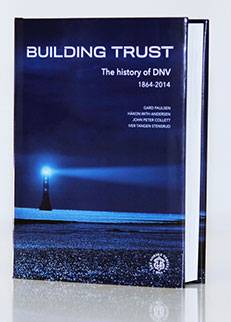New Book Examines DNV's 150-year History
Det Norske Veritas (DNV) began in 1864 as a small Norwegian classification society, and in the 150 years since, has grown into one of the world’s largest enterprises of its kind with the formation of DNV GL in 2013.
As part of the group’s anniversary celebration, DNV GL launched a book entitled “Building Trust: the History of DNV 1864-2014,” telling the tale of the organization’s development throughout its 150-year history, drawing attention to the group’s sociological contributions through the years. The book, written by Norwegian historians Gard Paulsen, Håkon With Andersen, John Peter Collett and Iver Tangen Stensrud, is a result of a four-year research project in the department of historical studies at the Norwegian University of Science and Technology (NTNU).
“Celebrating the 150th anniversary of Det Norske Veritas provides an opportunity both to understand and acknowledge our history better, and to use a deeper grasp of the past as knowledge and inspiration for our meeting with the future,” said Henrik O. Madsen, President & CEO of the DNV GL Group.
Since 1864, DNV has been a participant in a major social development in Norway through key roles as inspector, consultant and prime mover in the internationalization of Norwegian shipping. It later acquired a similar role in the evolution of Norway’s oil and offshore technology, and eventually in a number of other industries both nationally and internationally.
In a broader perspective, DNV has contributed to creating trust between players in shipping and industry, between suppliers and customers, and in technology and systems. By issuing certificates, conducting inspections, defining norms and setting standards in a number of areas, the society has facilitated trade and transport, made agreements possible between geographically separated parties, influenced marine insurance and financing, and regulated aspects of maritime technology.
However, DNV has contributed particularly to strengthening quality and safety in the shipping industry and subsequently in the far more demanding oil and offshore sector. The history of DNV is also the story of risk management as a specialty and a precondition for technological development in society.
The services represented by DNV can be understood as mechanisms in what could be called the almost invisible infrastructure of trust, both in Norway and internationally. These are mechanisms which have dealt over a long period with risk, threats and trust deficits in industries of great social significance, such as shipping and petroleum.
Little attention has been paid to trust and trust-building mechanisms as preconditions and essential infrastructure for an increasingly globalised society. In that respect, the history of DNV should make an important contribution to a necessary and exciting sociological discussion with both political and economic aspects. Building Trust contributes to an academic understanding of how these mechanisms have emerged, how they have evolved over time, what they have embraced, what authority they have operated with, and what forms of knowledge and relationships have been required for this.
The story of the Norwegian classification society established 150 years ago is therefore about something more than substantial diversification and internationalization. It also relates how a private enterprise such as DNV has secured and been awarded assignments which regulate basic social conditions.
In the final section of the book, a separate chapter is devoted to the immediate past and the merger with Germany’s Germanischer Lloyd. The book concludes with a broad overview of DNV’s history, which maps out developments from the first register of ships published by the society in 1865 to its many different assignments and services today. Then as now, the challenge was to strike a balance between providing trustworthy information to market players – primarily marine underwriters and charterers – and regulating conditions of great social importance and interest. The ways DNV achieved this balance has varied over time, but it has always possessed a great ability to change and adapt to alterations in markets, political regimes and technologies – an almost systematic pragmatism has long been a key characteristic of the society.
Building Trust is published in English by Norway’s Dinamo Forlag, and a total of 25,000 copies have been printed by TBB in Slovakia. In addition to being used as a gift, the book will be available through libraries and booksellers.
dnvgl.com


















